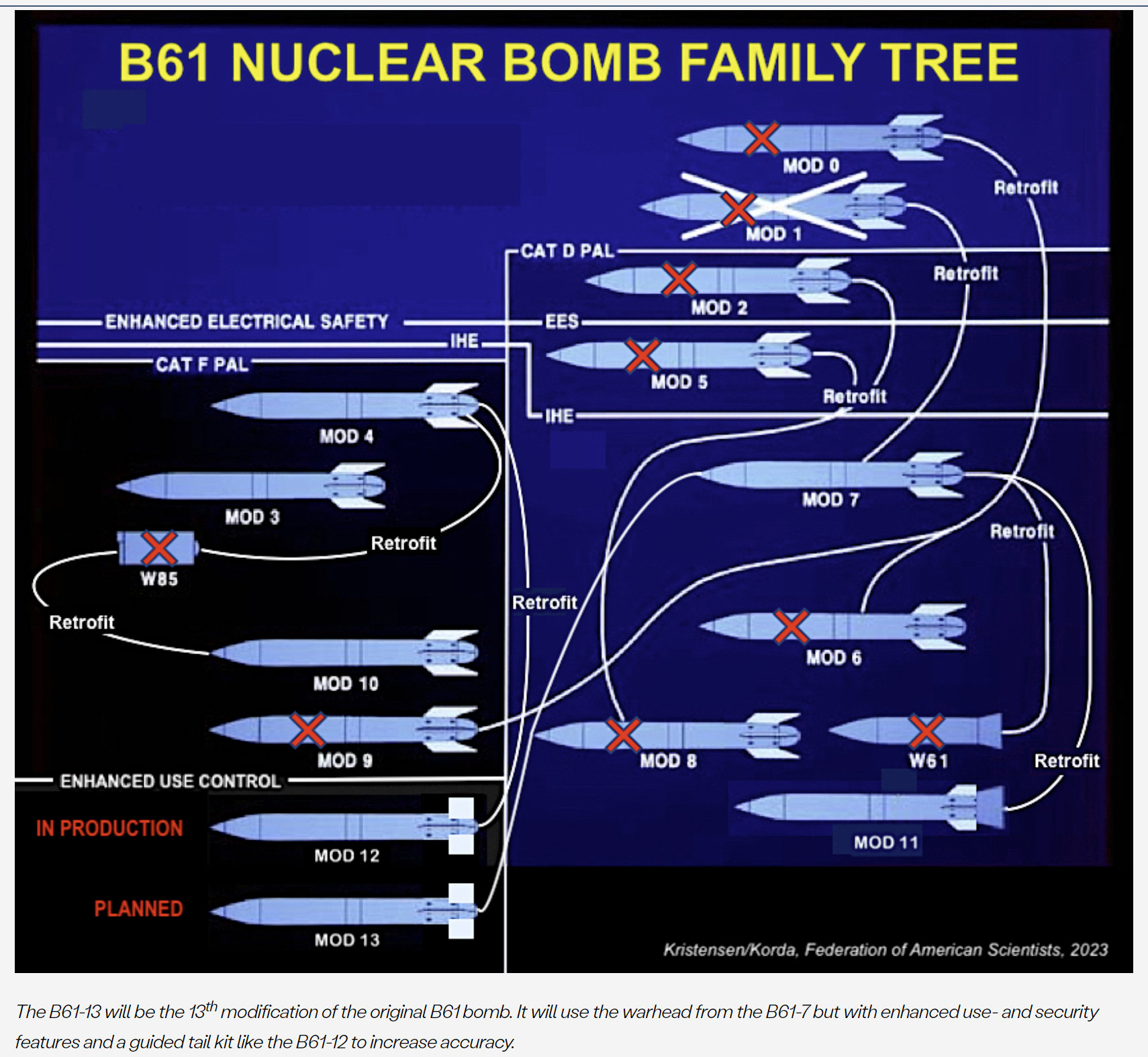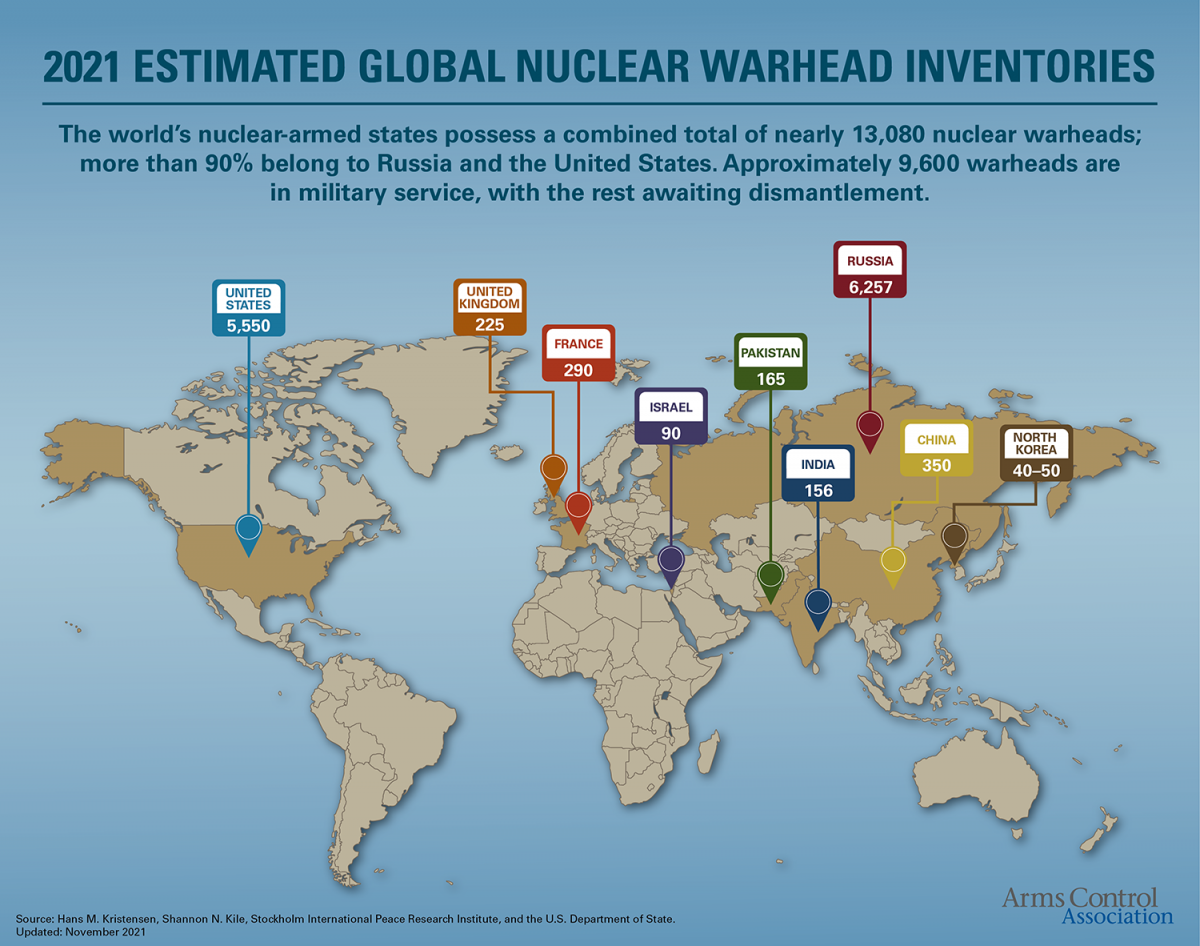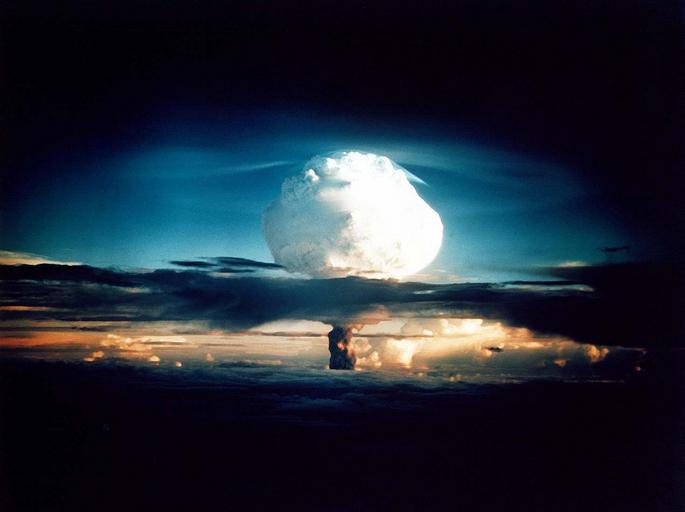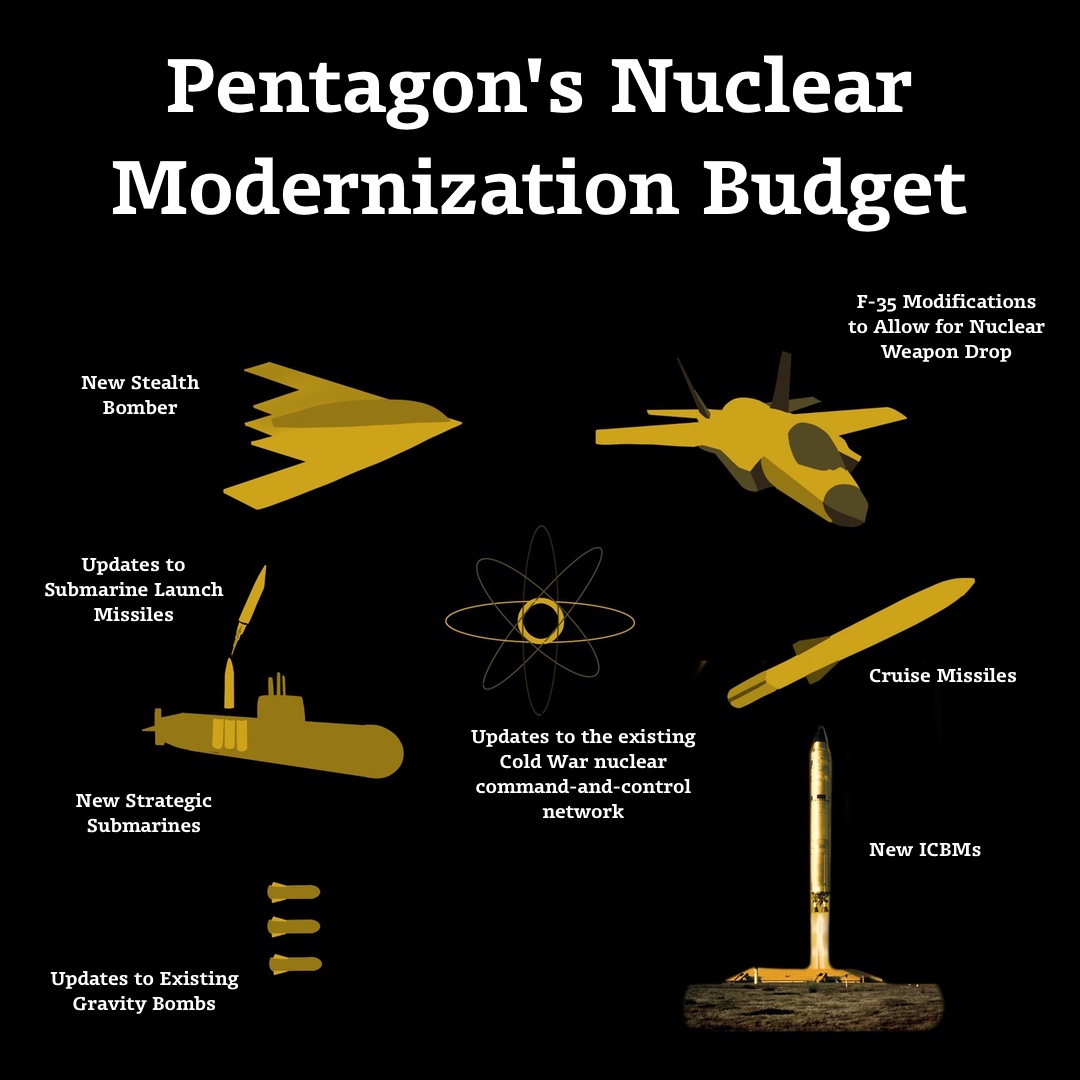RECENT UPDATES
Nuclear Weapons Issues & The Accelerating Arms Race: November 2023
Nuclear weapons issues
New bomb: The Pentagon has announced a new nuclear bomb, the B61-13. The B61-12 is now in production and will be forward deployed in Europe. But it has a dial-a-yield that maxes out at 50 kilotons. The new B61-13 will max out at 360 kt to get at hardened deeply buried targets (both have limited earth-penetrating capabilities). At one time, production of the B61-12 at least potentially signified retirement of the 1.2 megaton surface burst B83 strategic bomb, but now production of the B61-13 will probably be relatively quick at the tail end of already scheduled B61-12 production.
See: https://www.defense.gov/News/Releases/Release/Article/3571660/department-of-defense-announces-pursuit-of-b61-gravity-bomb-variant/ and https://media.defense.gov/2023/Oct/27/2003329624/-1/-1/1/B61-13-FACT-SHEET.PDF
See excellent analysis by the Federation of American Scientists:
https://fas.org/publication/biden-administration-to-build-a-new-nuclear-bomb/
Strategic Posture Review: Commissioned by Congress,
“The Commission recommends that a strategy to address the two-nuclear-peer threat [Russia and China] environment be a prerequisite for developing U.S. nuclear arms control limits for the 2027-2035 timeframe. The Commission recommends that once a strategy and its related force requirements are established, the U.S. government determine whether and how nuclear arms control limits continue to enhance U.S. security…”
Continue reading
Biden’s Nuclear Posture Review Fuels the New Nuclear Arms Race
FOR IMMEDIATE RELEASE, October 27, 2022 |
Jay Coghlan, 505.989.7342 jay@nukewatch.org
Santa Fe, NM– Today, the Biden Administration has released its long awaited unclassified Nuclear Posture Review. It headlines a “Comprehensive, balanced approach to defending vital national security interests and reducing nuclear dangers.” It also declares that “deterrence alone will not reduce nuclear dangers.”
“Deterrence” against others has always been the publicly sold rationale for the United States’ nuclear weapons stockpile. First, there is the inconvenient fact that the U.S. was the first and only to use nuclear weapons in war. But secondly, the United States and the USSR (now Russia) never possessed their huge stockpiles for the sole purpose of deterrence anyway. Instead, their nuclear weapons policies have always been a hybrid of deterrence and nuclear war fighting, which threatens global annihilation to this very day.
FULL PRESS RELEASE [PDF]
Why Funding for the SLCM Nuclear Warhead Should Be Deleted
Introduction: In 1991, in response to the ongoing collapse of the Soviet Union, President George H. Bush ordered the withdrawal of all nuclear-armed sea-launched cruise missiles (SLCMs) from U.S. surface ships and submarines. In 2018 President Trump’s Nuclear Posture Review proposed to redeploy SLCMs on Virginia-class attack submarines, saying they would provide the United States with “a needed non-strategic regional presence” that would address “the increasing need for flexible and low-yield options.”1 Congress subsequently approved $15.2 million in FY 2022 funding for the Navy’s new cruise missile and nuclear warhead.
In March 2022 President Biden transmitted a new classified Nuclear Posture Review to Congress that reportedly canceled the Sea-Launched Cruise Missile. In parallel, his proposed FY 2023 budget for the National Nuclear Security Administration (NNSA) has no funding for the SLCM nuclear warhead. This has prompted some congressional pushback, with one suggested compromise being continuing modest research funding. But as a Congressional Research Service analysis put it: “The Navy indicated that the program was “cost prohibitive and the acquisition schedule would have delivered capability late to need.”
Nuclear missiles, bombs market to surge 73% by 2030: Report
“…International treaties and consortiums discourage nuclear testing,” the firm said in a report summary. “This hampers the market growth.”
By Sarah Morland, Reuters | April 4, 2022 livemint.com
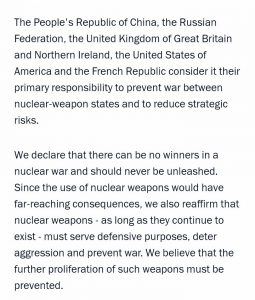 US President Joe Biden last week requested a record peacetime national defence budget, which would prioritise modernizing its nuclear “triad” of ballistic missile submarines, bombers and land-based missiles.
US President Joe Biden last week requested a record peacetime national defence budget, which would prioritise modernizing its nuclear “triad” of ballistic missile submarines, bombers and land-based missiles.
The report predicted that demand for small nuclear warheads, which can be easily deployed through aircraft and land-based missiles, would fuel faster growth in these segments, although submarine-launched ballistic missiles (SLBMs) accounted for a quarter of the market in 2020.
While North America dominated more than half the global market in 2020, the report predicted the fastest growth would come from the Asia-Pacific region on initiatives by India, Pakistan and China to bolster their nuclear arsenals.
“However, international treaties and consortiums discourage nuclear testing,” the firm said in a report summary. “This hampers the market growth.”
It predicted that the rising influence of non-nuclear proliferation treaties and national efforts should increase the number of warheads in storage or awaiting dismantlement.
Active weapons, however, accounted for the “lion’s share” – more than two-thirds – of the market in 2020, it said, due to investment in nuclear arsenals and new warhead purchases.
Britain, China, France, Russia and the United States at the start of the year issued a joint statement saying there could be no winners in a nuclear war and it must be avoided.
A Megaton of Waste
The White House’s new defense budget lavishes money on America’s nuclear weapons program in the name of competing with China and Russia. It’s totally unnecessary.
“Biden has scaled back his domestic ambitions even while pushing the defense budget upward and onward.”
By Fred Kaplan SLATE | March 30, 2022 slate.com
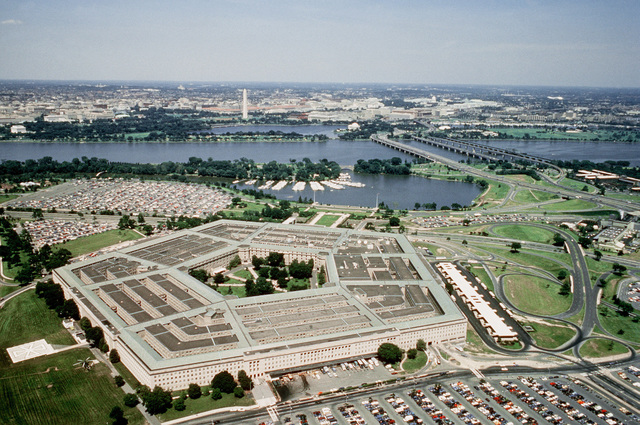
President Joe Biden’s defense budget for 2023 is gargantuan. It comes to $813.3 billion, nearly $60 billion higher than the budget he requested a year ago for 2022. Just a few weeks ago, Congress passed a bill adding $25 billion to that earlier budget. Biden’s new budget, which he submitted on Monday, accepts the congressional hike as a baseline and raises the pot by another $32 billion.
To put this in perspective, Biden’s $813 billion exceeds President Donald Trump’s final defense budget by $75 billion—which, for a sense of proportion, is about 2.5 times what the government spends on Pell grants for low-income college students. It tops the amount that the Trump administration figured it would spend in 2023 by $40 billion.
Current U.S. Nuclear Weapons Issues: New Year’s Update — January 15, 2022
U.S. nuclear weapons issues:
- In anticipation of the NonProliferation Treaty Review Conference that was to start January 4 the P-5 (original nuclear weapons powers U.S., Russia, China, France and U.K.) came out with an unbelievable collective statement on how they are in compliance with the NPT Article VI mandate to disarm. Then the Review Conference was indefinitely postponed because of omicron.
- Biden signed the FY 2022 Defense Authorization Act (DAA). Congress gave the Pentagon $24 billion more than Biden asked for. So much for ending endless wars. The DAA fully authorizes what the Biden Administration asked for National Nuclear Security Administration nuclear weapons programs, which increased Trump’s FY 2021 budget which saw a 25% from his FY 2002 budget. LANL is to get a cool billion in FY 2022 for expanded plutonium pit production alone.
- Still no appropriations. Second Continuing Resolution (CR) runs out in February.
- First anniversary of Treaty on the Prohibition of Nuclear Weapons January 22
Current U.S. Nuclear Weapons Issues: Monthly Update — December 15, 2021
FY 2022 National Defense Authorization Act: The Bad News.
As Politico put it:
PROGRESSIVES’ PENTAGON POUNDING: … progressives barely put their stamp on Pentagon policy this go-round. Bipartisan provisions requiring women to register for the draft, cracking down on Saudi Arabia and imposing sanctions on Russia were nixed; legislation repealing outdated Iraq war authorizations fell by the wayside; reforms to the military justice system and efforts to combat extremism in the ranks were pared back; and a proposal to give Washington, D.C., control of its National Guard was dropped,” they wrote. Democrats hold power in the House, Senate and White House for the first time in more than a decade, yet the high-profile defense bill got more GOP votes than from Biden’s own party. As progressive lawmakers made their dissatisfaction with the bill’s high price tag clear, centrist Democrats knew they needed Republican support to pass the House and Senate.”
Progressives truly felt they had a historic chance to turn their priorities into policy, but the realities of a 50-50 Senate with no filibuster made that near impossible. And with midterms next year, it’s likely they missed their best chance.
Nuclear weapons: Congress added $500 million to Biden’s request for NNSA Total Weapons Activities, which was essentially Trump’s request to begin with. Trump’s Sea-Launched Cruise Missile and B83 (1.2 megatons) service life program were kept. $1.72 billion request for “Plutonium Modernization” authorized.
- However, the NDAA is authorization, not appropriations. The 2nd Continuing Resolution runs until February after which the appropriators will have to come up with something. There’s a chance that the Sea-Launched Cruise Missile and B83 sustainment program could be shot down. While those would be notable victories, they really only amount to damage control (i.e., rolling back two of Trump’s pet projects) as the $1.7 trillion modernization beast lumbers on.
Current U.S. Nuclear Weapons Issues Updates — November 15, 2021
The current Continuing Resolution keeping the government running expires 12/3. Another Continuing Resolution is likely.
The Pentagon has released a major threat assessment of China at https://media.defense.gov/2021/Nov/03/2002885874/-1/-1/0/2021-CMPR-FINAL.PDF.
Under “Nuclear Capabilities” it concludes:
► Over the next decade, the PRC [People’s Republic of China] aims to modernize, diversify, and expand its nuclear forces.
► The PRC is investing in, and expanding, the number of its land-, sea-, and air-based nuclear delivery platforms and constructing the infrastructure necessary to support this major expansion of its nuclear forces.
► The PRC is also supporting this expansion by increasing its capacity to produce and separate plutonium by constructing fast breeder reactors and reprocessing facilities.
► The accelerating pace of the PRC’s nuclear expansion may enable the PRC to have up to 700 deliverable nuclear warheads by 2027. The PRC likely intends to have at least 1,000 warheads by 2030, exceeding the pace and size the DoD projected in 2020.
► The PRC has possibly already established a nascent “nuclear triad” with the development of a nuclear capable air-launched ballistic missile (ALBM) and improvement of its ground and sea-based nuclear capabilities.
► New developments in 2020 further suggest that the PRC intends to increase the peacetime readiness of its nuclear forces by moving to a launch-on-warning (LOW) posture with an expanded silo-based force.
This is bound to have a major influence on Biden’s Nuclear Posture Review, to be released in early 2022. China’s expansion of its nuclear weapons capabilities, along with U.S. and Russian “modernization” programs, may also be big issues at the January 2022 NonProliferation Treaty Review Conference.
Nuclear Officials Discuss Modernization of Arsenal in Online Forum
“Officials at the National Nuclear Security Administration have said the earlier estimate of Savannah River meeting its pit production target in 2030 was unrealistic and that it could take until 2035.
Meanwhile, the most recent cost estimate for bringing Savannah River’s pit plant online has swelled to $11 billion from $4.6 billion.”
BY: Scott Wyland swyland@sfnewmexican.com Jul 20, 2021
A group of nuclear weapons managers agreed Tuesday that making more plutonium cores for warheads will be key to modernizing the nation’s arsenal as a deterrent against rival countries.
But during an online forum, a few of the managers who work at facilities with nuclear weapons programs also delved into a military leader’s assertion in recent months the U.S. is unable to produce a brand-new nuclear weapon, unlike Russia and China.
Peter Heussy, a defense consultant, asked the panel to interpret the comments by Adm. Charles Richard, head of U.S. Strategic Command, based on their work in the field.
“My thinking is: By policy we’re not supposed to be designing new [weapons]. We’re not being asked to do it, either,” said Mark Martinez, who oversees mission support and testing at the Nevada National Security Site.
The current focus is on life extension, Martinez said, referring to the program to replace or upgrade aging components, including the softball-sized plutonium cores — or pits — that detonate warheads.
Plans call for Los Alamos National Laboratory to produce 30 pits by 2026 and Savannah River Site in South Carolina to make 50 pits in the 2030s.
76 Years After the First Nuclear Bomb Test, the U.S. is Still Dead Set on Building New Weapons of Mass Destruction
Last week, July 16 2021, marked the 76th anniversary of the world’s first nuclear bomb explosion. Within another month, memorials and commemorations will be held for the Japanese cities of Hiroshima and Nagasaki, which the U.S. bombed on 6 and 9 August 1945, respectively. Although it was unknown to most residents of New Mexico until after the United States’ atomic bombing of Japan, the citizens and communities in the southern region of the state were in fact the first nuclear victims.
When the U.S. Army detonated an atomic bomb on July 16, 1945 at 5:29 a.m., “its thunderous roar during the rainy season knocked people from breakfast tables in Tularosa and sent others on the Mescalero Apache reservation into hiding.” (axios.com) Hispanics and Mescalero Apache tribal members in New Mexico are working to pressure lawmakers to compensate those who have suffered extremely because of the experiment. Rare forms of cancer and other health problems have been discovered in those living near the site of the Trinity Test, and the vast, noxious consequences of this experiment have had lasting impact on now multiple, entire generations.
The Pentagon considers eight projects part of its nuclear modernization budget: new ICBMs, cruise missiles, updates to submarine-launched missiles, a new stealth bomber, new strategic submarines, updates to existing gravity bombs, modifications to the F-35 fighter jet that allow it to drop nuclear weapons, and updates to the existing Cold War nuclear command-and-control network. Since 2013, Congress has approved about $67 billion for those, according to Forecast International, a data analysis firm owned by Defense One’s parent company. In fiscal 2021, the funding totaled $13 billion, or about 1.8 percent of the Pentagon’s $704 billion budget.
A Rough Breakdown of the Trillion Dollar Cost of Modernization:
1/3 NNSA
The National Nuclear Security Administration is a semi-autonomous agency within the Department of Energy
Warhead Production
- Warhead "Life Extension Programs"
- Includes upgrades to B61, W80, W76
- New plutonium pit production
- Includes upgrades to B61, W80, W76
- Nuclear Weapons Labs
- Nuclear Weapons Production Plants
- Other Facilities, infrastructure
2/3 Department of Defense
Warhead Delivery Systems
- Land-Based ICBMs
- 642 (400 to deploy) new ICBMs
- SSBNs: Ballistic Missile Submarines
- 12 new Columbia Class SSBNs
- Bombers & Air-Launched Cruise Missiles
- Upgrades to the B-1, the B-2, and the B-52
- LRSB: 100 new B-21 strategic bombers
- LRSO: 1000+ nuclear-capable cruise missiles
- Upgrades to the B-1, the B-2, and the B-52
Warhead Production and 'Life Extension Programs'
- The W76 was chosen as a SSBN (submarine-launched ICBM) warhead.
- The W80-4 is to be the warhead for the next-gen nuclear cruise missile (LRSO).
- The B61-12 upgrade with new Tail-kit.
- Plutonium pit production.
Note that the NNSA (National Nuclear Security Administration) runs all weapons related activities under the DOE. Environmental cleanup of wastes from nuclear weapons production is under the jurisdiction of the DOE without NNSA involvement. While the NNSA budget is set to increase, DOE's is set to decrease.
Warhead Delivery Systems
- New ICBMs (aka GBSD, or Ground-Based-Strategic-Deterrent): This is a contested element of the planned triad modernization. William Perry and others have argued that land-based ICBMs are the one way a computer glitch could end up triggering total nuclear war, and should therefore be eliminated in favor of bombers and SSBNs. Boeing, Northrup Grumman, and Lockheed have submitted bids for the roughly $70 billion job.
- SSBNs are to be designed and built by Electric Boat in Connecticut. Plans call to build 12, at a cost $5 billion apiece, and no-one knows where those funds will come from. There's been talk of a supplemental Sea-Borne Deterrence Fund; but Air Force wants a similar budgetary trick for its nuclear systems.
- Bombers: Northrup Grumman is prime contractor on the new B-21 as well as the B-2 upgrade. Boeing is contractor for B1 and B52 upgrades.
- Long-Range Stand-Off cruise missiles: This is the other most contested of the new systems planned, with many experts calling it dangerous and unnecessary. Air Force has issued a call for bids for 1000+ missiles. Boeing, Raytheon, Northrop Grumman, and Lockheed Martin are expected to submit bids.
Resources
Nothing Found
It seems we can’t find what you’re looking for. Perhaps searching can help.
Quotes
Nothing Found
It seems we can’t find what you’re looking for. Perhaps searching can help.

